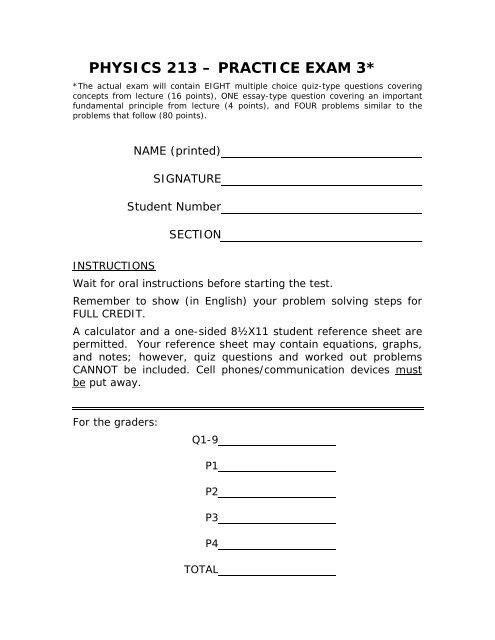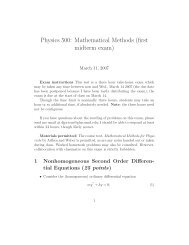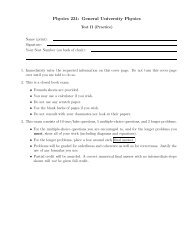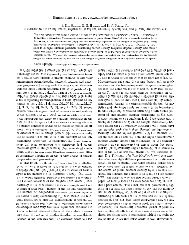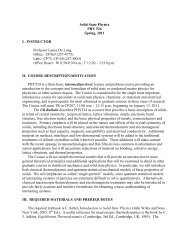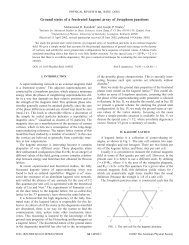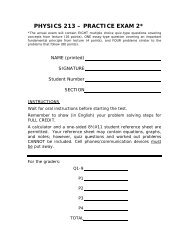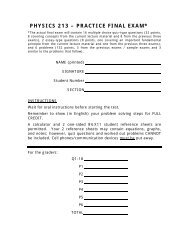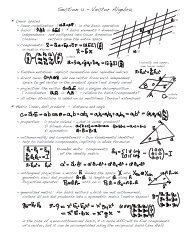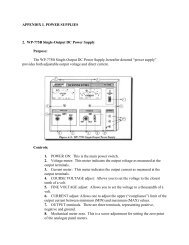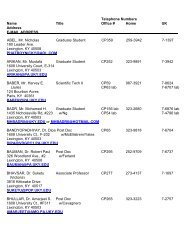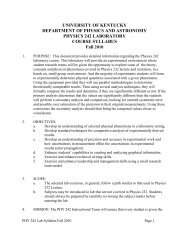Sample Exam
Sample Exam
Sample Exam
Create successful ePaper yourself
Turn your PDF publications into a flip-book with our unique Google optimized e-Paper software.
PHYSICS 213 – PRACTICE EXAM 3*<br />
*The actual exam will contain EIGHT multiple choice quiz-type questions covering<br />
concepts from lecture (16 points), ONE essay-type question covering an important<br />
fundamental principle from lecture (4 points), and FOUR problems similar to the<br />
problems that follow (80 points).<br />
NAME (printed)<br />
SIGNATURE<br />
Student Number<br />
SECTION<br />
INSTRUCTIONS<br />
Wait for oral instructions before starting the test.<br />
Remember to show (in English) your problem solving steps for<br />
FULL CREDIT.<br />
A calculator and a one-sided 8½X11 student reference sheet are<br />
permitted. Your reference sheet may contain equations, graphs,<br />
and notes; however, quiz questions and worked out problems<br />
CANNOT be included. Cell phones/communication devices must<br />
be put away.<br />
For the graders:<br />
Q1-9<br />
P1<br />
P2<br />
P3<br />
P4<br />
TOTAL
Electromagnetic Waves [20 Points]<br />
A large parabolic solar detector with radius 25.0 m is mounted to a solar<br />
probe with total mass 2500 kg which is placed in space near the Earth’s<br />
orbit. The solar detector absorbs solar radiation with intensity 1340 W/m 2 .<br />
a) Find the amplitude of the electric field for the solar radiation? [5 points]<br />
Answer: E = 1005 V/m<br />
b) Find the amplitude of the magnetic field for the solar radiation? [4 points]<br />
Answer: B = 3.35 µT<br />
c) Determine the solar power absorbed by the solar detector. [3 points]<br />
Answer: P = 2.63 MW<br />
d) Ignoring all gravitational effects, determine the acceleration of the solar<br />
probe due to the soar radiation pressure. [4 points]<br />
Answer: a = 3.51 x 10 -6 m/s 2<br />
e) Find the probe’s speed as it reaches Mars 7.80 x 10 10 m away. Ignore all<br />
gravitational effects and assume the probe starts from rest and the solar<br />
intensity remains constant. [4 points]<br />
Answer: v = 740 m/s
Snell’s Law [20 Points]<br />
A beam of light passes through different layers of materials with different<br />
indices of refraction as shown in the figure.<br />
a) If the beam emerges at θ 2 = 50°, find the incident angle θ 1 . [8 Points]<br />
Answer: θ 1 = 28.6°<br />
b) What must be the incident angle θ 1 in order to have total internal<br />
reflection occur at the bottom surface between the medium with n = 1.20<br />
and the medium with n = 1.00? [6 Points]<br />
Answer: θ 1 = 38.7°<br />
c) If total internal reflection occurs at the bottom and top surfaces (when the<br />
incident angle is what you calculated in part b), how many reflections will<br />
occur between the top and bottom surfaces if all layers are 5.00 m in<br />
length and 25.0 cm in width? [6 Points]<br />
Answer: N = 6.00 reflections
Dispersion and Total Internal Reflection [20 Points]<br />
As shown below, white light is incident normally on a face of a 30 o -60 o -90 o<br />
flint prism (n 1 = 1.655 for violent light and n 1 = 1.595 for red light), that is<br />
immersed in water (n 2 = 1.333). The ray undergoes total internal reflection<br />
at point P.<br />
n 2<br />
60<br />
n 2<br />
P<br />
n 1<br />
n 2<br />
θ<br />
a) Determine the exit angle θ for red and violet light. What is the dispersion<br />
of the prism? [14 Points]<br />
Answer: θ red = 36.7°, θ violet = 38.4°, and Δθ = 1.7°<br />
b) A substance is dissolved in the water to increase the index of refraction.<br />
At what value of n 2 of the mixture will total internal reflection cease at<br />
point P for red and violet light? [6 Points]<br />
Answer: n 2 = 1.381 (red) and n 2 = 1.433 (violet)
Mirrors [20 Points]<br />
I) High school kids are always worried about pimples. When I was an<br />
adolescent, I had one of those magnifying shaving mirrors with which I<br />
perused my physiognomy diligently. If you place your face 15 cm from<br />
the mirror, what focal length is required to provide a magnification of<br />
1.33? Draw the convenient type of mirror (concave or convex) and draw<br />
the rays. [10 Points]<br />
Answer: 60 cm and concave mirror<br />
II) An object is placed at a distance of p = 20 cm in front of a convex mirror<br />
of focal length f = -10 cm as shown.<br />
a) Where is the image located with respect to the mirror? Is the image<br />
virtual or real? Inverted or upright? [6 Points]<br />
Answer: 6.67 cm behind the mirror, virtual, upright<br />
b) What is the magnification of the mirror? [4 Points]<br />
Answer: M = 0.333
Combination of Lenses [20 Points]<br />
The object is placed 60 cm in front of a diverging lens with a focal length of<br />
-15 cm. A converging lens of focal length 20 cm is placed 10 cm behind the<br />
first lens.<br />
a) Make a diagram indicating the position of the lenses, the object and final<br />
image, and the corresponding distances measured from the origin.<br />
Assume the optical system is along the x-axis and take x = 0, as the<br />
position of the diverging lens. [10 Points]<br />
Answer: Final image is real, inverted at 230 cm. Diagram is shown.<br />
b) Find the magnification of the two lens system. [4 Points]<br />
Answer: M = -2<br />
c) Repeat parts a) and b) for the case when the object is placed 10 cm in<br />
front of the diverging lens. [6 Points]<br />
Answer: Final image is virtual, upright at -70 cm with M = 3
Interference [20 Points]<br />
An airplane is traveling 100 m above two radio<br />
transmitters with the same height and a<br />
distance d = 5.00 m apart. The radio signal<br />
emitted from both transmitters has a<br />
wavelength of λ = 75.0 cm. The signal<br />
received by the airplane can be used to<br />
determine the location of the airplane with<br />
respect to the midpoint between the two<br />
transmitters.<br />
a) Determine how far the airplane is from the<br />
midpoint between the two transmitters if<br />
the radio signal received is at the third<br />
maximum? [8 Points]<br />
Answer: 112 m<br />
b) Determine how much further the airplane must travel horizontally to<br />
reach the next maximum. [6 Points]<br />
Answer: 24.6 m<br />
c) Suppose the space in which the waves are traveling is replaced with<br />
seawater of refractive index n = 1.35 and the airplane is replaced by a<br />
submarine. What would be the answer to parts a) and b)? [6 Points]<br />
Answer: 106 m, 14.3 m
Diffraction [20 Points]<br />
The emission of light from an excited gas is focused and passed through a<br />
diffraction grating with 3000 lines/cm, as shown. First order and second<br />
order spectral lines are observed.<br />
a) Four first-order spectral lines are observed at 7.07°, 7.48°, 8.38°, and<br />
11.3°. Find the wavelengths of these four spectral lines. [8 Points]<br />
Answer: λ 1 = 410 nm, λ 2 = 434 nm, λ 3 = 486 nm, and λ 4 = 656 nm<br />
b) At what angles are the second-order spectral lines observed? [7 Points]<br />
Answer: θ 1 = 14.2°, θ 2 = 15.1°, θ 3 = 17.0°, and θ 4 = 23.2°<br />
c) Suppose the diffraction grating is replaced with another having twice the<br />
number of gratings/cm. Find the angular separation observed between<br />
the second-order spectral lines. [5 Points]<br />
Answer: Δθ = 22.5°
Polarization [20 Points]<br />
Three polarizing plates whose planes are parallel are centered on a common<br />
axis. The directions of the transmission axes relative to the common vertical<br />
direction are shown in the figure. A linearly polarized beam of light with<br />
plane of polarization parallel to the vertical reference direction is incident<br />
from the left onto the first disk with intensity I i = 100 W/m 2 .<br />
a) Determine the transmitted intensity I f when θ 1 = 10.0°, θ 2 = 30.0°, and<br />
θ 3 = 60.0°. [7 Points]<br />
Answer: I f = 64.2 W/m 2<br />
b) What is the ratio I f /I i of the final transmitted intensity to the incident<br />
intensity if θ 1 = 30.0°, θ 2 = 60.0°, and θ 3 = 90.0°? [7 Points]<br />
Answer: I f /I i = 27/64<br />
c) If θ 1 = 0° and θ 2 = 45.0°, what should θ 3 be in order to make I f /I i = 3/8?<br />
[6 Points]<br />
Answer: θ 3 = 75.0°


